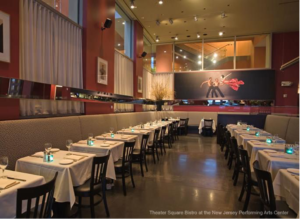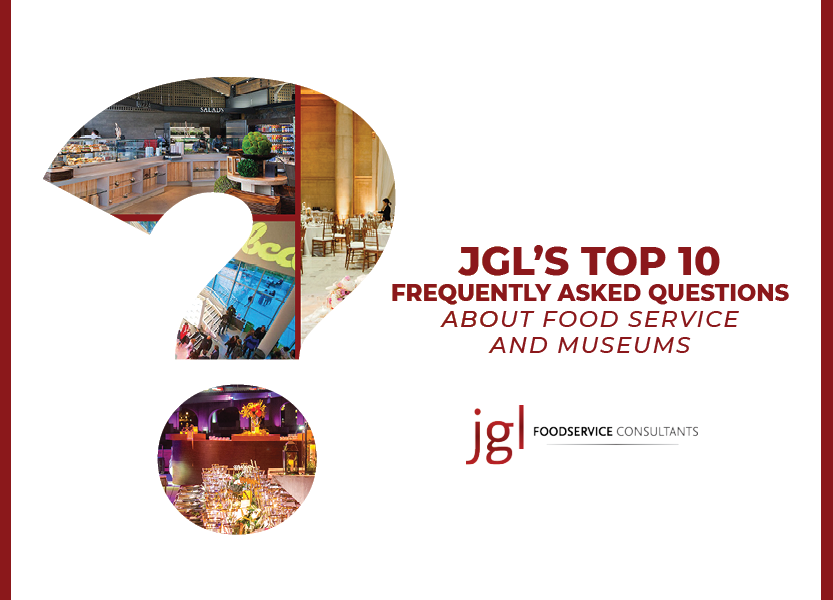
With over 35 years of experience, we’ve heard just about every question possible! Our team has compiled the most commonly asked questions by cultural institutions as they pertain to on-site food services. If you are thinking about starting an on-site food service operation or already have one in place, we hope you find this information useful.
1. Is there a minimum attendance level required for a museum café?
We believe that some kind of visitor food option can be developed for most institutions. Visitor food can enhance the visitor experience, deepen ties to the institution, increase the length of stay, and may stimulate gift shop sales. Smaller institutions can consider a simple kiosk or mobile cart that is weekend or seasonally programmed.
2. We want to develop a museum café but we do not have room for a full kitchen. What do you recommend?
A large number of museum café operations are supplied from outside kitchens (called commissaries). This allows the museum to preserve valuable space for museum collections and generally negates the need for a hood and fire suppression system in the smaller onsite support kitchen.
3. Where is the best location for a museum café?
The best location is one the visitor sees upon entry to the museum, ideally near the gift shop. This is not possible in many facilities. If the café is not highly visible, be sure to have good directional signage with-in the museum and feature it prominently on the museum website, all maps, and collateral material.
4. We know our museum café will not be profitable but we cannot afford to subsidize it. Are there options?
Catering operations are much more profitable than café operations. Consider a short preferred caterer list or an exclusive caterer. You can also bundle the liquor rights with the catering operation or guarantee a certain volume of internal catering. The more catering opportunities an Operator can capture, the more likely they are to support an amenity project on behalf of the institution.
5. Our trustees are convinced a “destination restaurant” will generate sizable profits and be a draw to the institution. Do you agree?
The number of financially successful true “destination restaurants” within a museum environment are few and far between. Many more fail than succeed. A destination restaurant requires a separate outside entrance, heavy street traffic, and full control over hours, menu, and price points. It also helps to be in an area where there are other successful restaurants. Tread carefully here because the failure of a destination restaurant within the museum will be considered a failure of the museum.
6. Our caterer wants to take over event sales. What do you recommend?
It may not be a bad idea. Catering sales staff are generally much more sales driven than museum event staff. Consider all options. If you do hand the sales function over you should still retain control of the calendar unless the rental space is a dedicated event space.
7. Can we get our caterer to pay for new kitchen equipment or other investments?
Maybe. It depends upon the sales potential, the term of the contract, and the amount of the investment. Generally an investment is only possible in an exclusive relationship.
8. What is the optimal contract length?
It depends upon whether there is an investment requirement, the start-up cost, and the volume of sales activity. A contract with no investment might be as short as 3 years. The average in our practice is 5-7 years. A contract with significant investment might be 10 years plus. Regardless of the length of the contract, it is critical the museum have the right to terminate without cause at any time.
9. Is an exclusive relationship or a preferred caterers list the better choice?
It depends upon the norms in your market and the goals of the food service program. We do not generally advise developing an exclusive relationship if the rest of the market has a long preferred list because that will create a negative differentiation. Below is a chart that highlights the commonly accepted advantages and disadvantages of each:

10. What is the average percentage or fee paid to museums by their caterers?
For catering the starting commission nationwide is 10% on food and beverage and the current average is 13%. Commission terms are based on sales volume; sometimes an Operator will present a sliding scale that will include increased commissions (well above the national average) once catering sales pass a specific threshold. Catering commission may be reduced if there is a requirement to run a visitor food operation, a significant investment, or a short-term contract.

